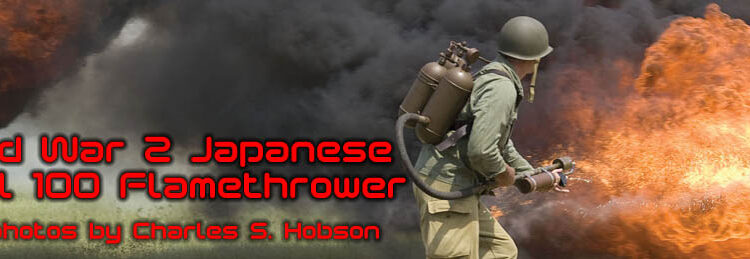By Charles S. Hobson
The author has been rebuilding flamethrowers, safety testing, writing historical articles, teaching safe operation, firing flamethrowers at shows and collecting data on flamethrowers for over fifteen years. In December 2007, he acquired a Japanese Model 100 in very good condition with extra parts for servicing. This unit was restored to operating condition and is now the only know example in existence of a working WWII Japanese flamethrower. This unit was used to accurately determine performance and dispel some of the myths about the Japanese flamethrower of WWII. For more information, or to contact the author, visit flamethrowerexpert.com.
At the beginning of the war in the Pacific, the US M1 flamethrower proved to be very unreliable while there was a desperate need for a reliable flame weapon to use against the determined and deeply entrenched Japanese soldier. During the Guadalcanal invasion, and for almost every subsequent invasion, Japanese flamethrowers were captured, but the Marines quickly discarded them as too small and with too little firepower. However, the Marines had been premature in their decision not to use captured flamethrowers on the enemy. After they had been shipped back to the Chemical Warfare Service in the US, it was discovered that the Japanese flamethrower had numerous superior features. These features were analyzed, copied, improved and incorporated in the design of the M2-2, which replaced the M1.
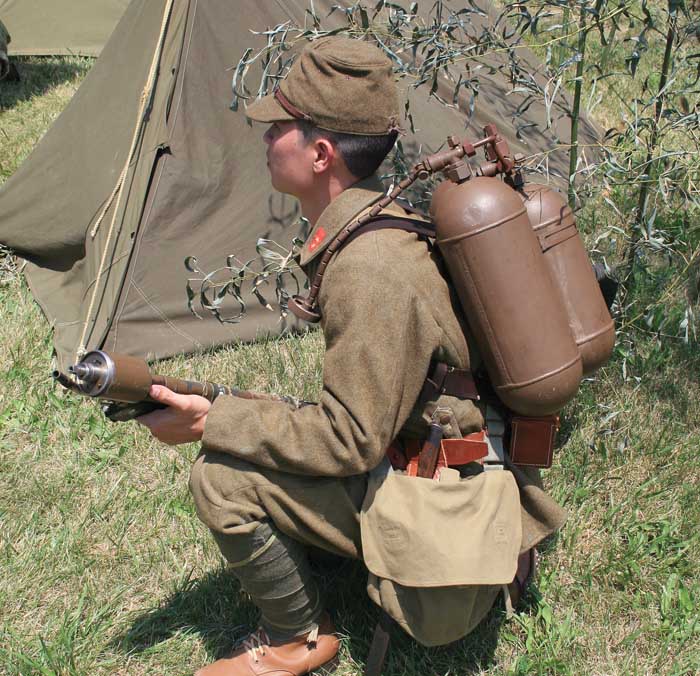
The first US flamethrower, the M1, had several design weaknesses, and it was a dismal failure because it was not resistant to the rain and humidity of the tropical Pacific climate. Because there was a desperate need for a weapon effective against the “fight to the death” determination of the Japanese soldier, tremendous effort was invested in an improved model. The M2-2 was so well built that properly serviced units operate flawlessly six decades later, and flamethrowers are becoming increasingly popular at public military historical shows.
The Japanese Models 93 and 100
The Japanese had only two models of portable flamethrowers: the Model 93 (1933) and Model 100 (1940). Both models used the exact same tank groups, but in the latter model the wand was shortened from 48 inches to 36 inches and the nozzle tip was machined to be removable. The M100 and M93 tank groups weighed 20 pounds and the wand and hose of the M100 weighed 10 lbs. Weight of the M100 fully loaded was 52 pounds. The tank group had a capacity of 3.5 gallons but only 2.75 was usable as the discharge for the hose was not at the bottom of the tanks, but 3.5 inches from the bottom. The M100 fired at a rate of 2.8 gallons per minute (gpm) compared to the US M1 of .5 gpm and both had firing durations of ten seconds. This data was from records compiled by the Chemical Warfare Service in August of 1944; however flamethrower records often contained inaccuracies. In many cases records were lost, conflicting, confusing, or simply never kept. Verification of data is possible if a flamethrower is restored and fired, allowing accurate measurements with confirmation of combat methods. An excellent example of conflicting data was the Japanese flamethrower fuel tank capacities. Two were given: the first was how much fuel could be put into the tanks, and the second was how much could actually be fired. This disparity created much confusion and many conflicting statements.
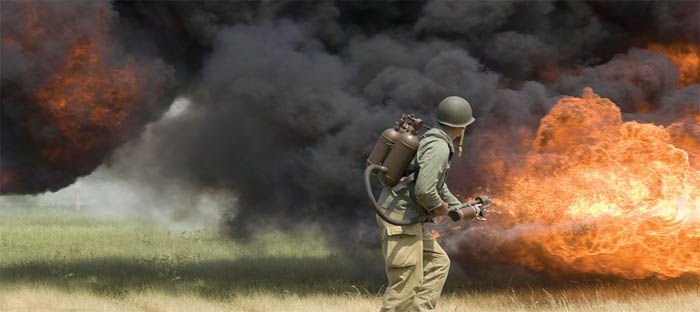
In early 2008, a Japanese M100 became available for testing and evaluation. The unit came to a US museum from Tokyo in 1946 with complete documentation, including railroad shipping documents. As an extra bonus, this flamethrower had two ignition cartridge cylinders, a wand in the original box, the filling dipstick, and a manifold to fill the fuel tanks. The US Naval Officer who arranged the acquisition also wrote in black pen the correct fill pressure for the nitrogen bottle. Information needed to test and fire the M100 came from the US Army Chemical Corps, museums, firsthand accounts, The Center for Military History, books, and private military collectors.
Using data and test equipment designed for the US Flamethrowers, conversion parts were machined to fit the Japanese WWII threads. The flamethrower was completely disassembled, cleaned, refitted with new seals, and tested for leaks. The fuel cells, wand and pressure bottle were each separately hydrostatically tested for twice the pressure they would experience when fired. Additional tests on the metal confirmed that the units would safely withstand working pressures.
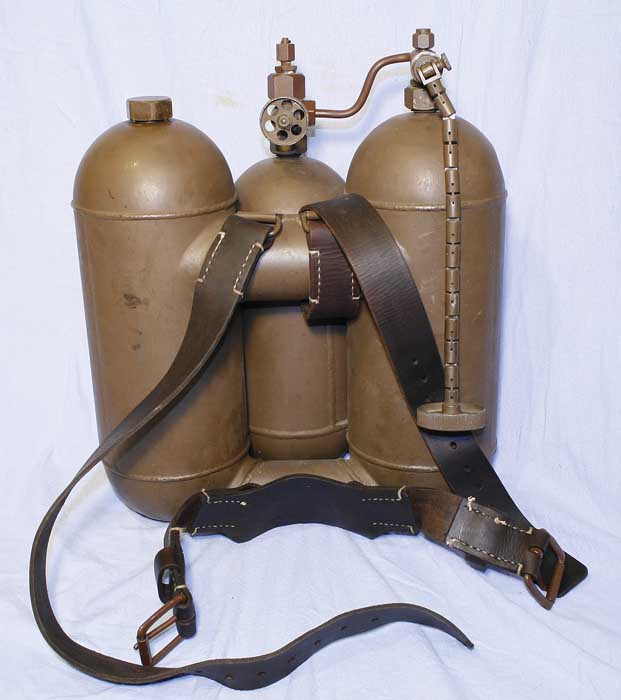
A note of caution: flamethrowers are inherently very dangerous. The possibility for rupture on a sixty year old pressure bottle or fuel cell is around 75%. Do not pressurize any flamethrower until it has been confirmed that it will safely hold twice the normal working pressure and you have redundant pressure relief systems.
The Japanese M100 is very comfortable and easy to walk with. For the average 110 pound WWII Japanese soldier, this would have been a reasonable load. When placed on a reenactor wearing an original Japanese WWII uniform, the fit of flamethrower to gear was perfect. The size of the tanks were designed to fit soldiers in standard combat gear. The leather straps are very comfortable and sewn in a cross-saddle configuration so they did not slip off the shoulder or allow the tanks to move on the operator’s back. Straps are easily adjustable but have no quick release.
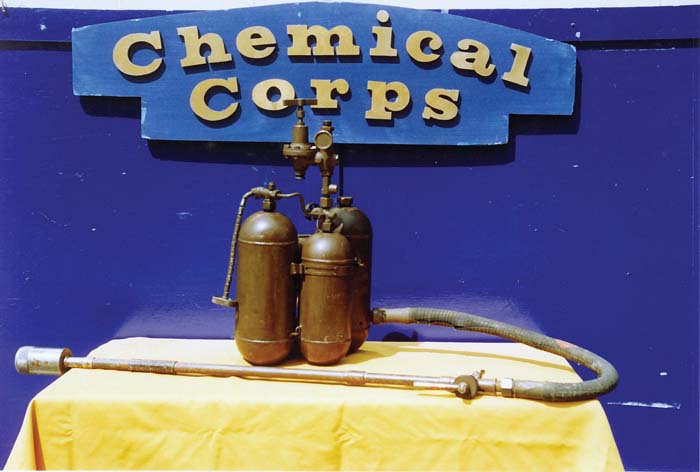
Ten ignition cartridges can be quickly loaded into a cylinder and loaded cylinders can be changed by simply unscrewing the entire assembly. Pyrotechnic charges were a vast improvement over the unreliable battery and high tension ignition of the US M1. However, there were accounts in WWII of Japanese flamethrowers not lighting in combat. This may have been due to bad cartridges, but it is also possible that the cartridges wouldn’t light the fuel as efficiently without an ignition shield to contain the flames. It is also possible that the black powder ignition mix was not hot enough as some reports stated the Japanese added gasoline until the fuel lit dependably. The US M2 cartridge contained magnesium, which greatly improved ignition.
Fueling the M100 tanks was difficult. The fuel cap was small, and the amount of fuel was critical, so the dipstick had to be checked often. Reading the clear fuel on the steel dipstick proved difficult even in good light – and impossible at night. The amount of fuel was important, as too much or too little fuel could affect the starting pressure in the tanks. The pressure bottle was easy to fill, with the exception of having to remove the steel connecting pipe between the pressure bottle and the tanks. This allowed dirt to enter the connections and increased the possibility of leaks. Dusty, rainy, or dirty conditions would cause serious problems keeping the unit pressurized. The Japanese nitrogen manifold used a regulator to prevent overfilling. Interestingly enough, the Model 93 was fired at 350 psi, (the US M2 operated at 380 psi) and the Model 100 was lowered to 250 psi. Today, all flamethrowers are fired at 250 psi, with pressure relief systems at 280 psi (with two more systems at pressures above that for double redundancy). Unless using gelled fuels, there was no difference in distance, but the firing duration decreases markedly. The Japanese pressure bottle was normally filled to 500 psi, and it could be filled as high as 700 psi.
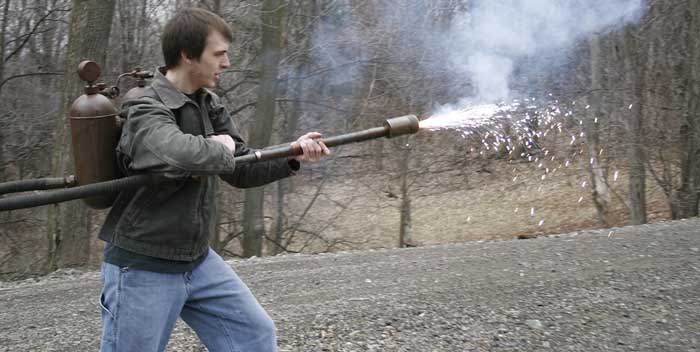
The M100 wand was difficult to use because of the way the valve worked. Practice was needed to operate the unit quickly and with control. The lever must be moved forward, and there was resistance as an attached lever moved forward to rotate the ignition cylinder and release the firing pin for each cartridge. This could have been very difficult for the smaller Japanese soldier if he were not conditioned and in very good physical shape. If something happened to the operator or he dropped the wand, it had no automatic shut off and would continue to fire. On the positive side, the valve was unlikely to turn itself on or light if dropped or jostled in shipping. Hopefully, the operator would not be shot or stumble when firing.
Firing the Japanese M100 revealed a few surprises. The US M1 and M2s used a high pressure bottle with maximum rating of 1,800 psi. A regulator maintained the pressure at 380 psi to allow maximum range with gelled fuel. With liquid fuels, pressures over 250 psi do not give additional range because the fuel is burned up before it can go further. In fact, the higher pressure causes the liquid fuel to ‘atomize’ and burn faster. The Japanese flamethrower does not have a regulator, and the fuel tank pressure drops as the fuel level decreases. This is because the space that the nitrogen occupies increases in volume. At the standard fill pressure of 500 psi, the bottle pressurizes the fuel tanks to 250 psi. Starting with 600 psi in the pressure bottle, the fuels cells are pressurized to 350 psi, and consequently the first shot is fired at 350 psi. Proper filling of the pressure bottle is critical to the range and volume of fire. In order to start with the full 250 psi in the fuel tanks, the fuel must be filled to exactly the full fuel line and the nitrogen bottle pressurized to exactly 500 psi.
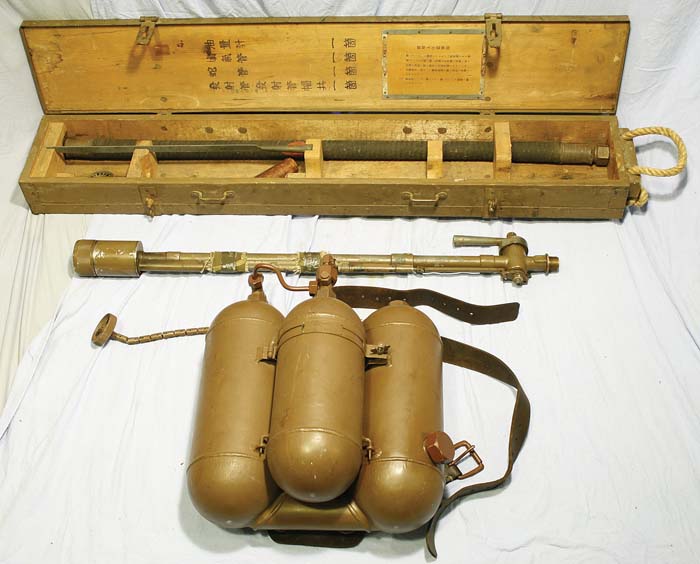
The biggest problem with the first US model M1 was that the operator could not turn it on unless he took it off his back. The Japanese solved this problem by attaching a flexible metal shaft to the pressure bottle valve. Although this was a positive improvement, the handle was hard to find and made a clanking noise when it banged against the tanks. The ability of the operator to turn on the tanks was critical for combat readiness as well as to reduce the chances of pressure leakage.
In combat, flamethrower pressure drop was not always a hindrance – at times it was actually an advantage. With the US flamethrowers, the operator could not engage a target at short range, as the flames would roll back dangerously. Even at distance of 30-40 feet, the heat would be unbearable. With the Japanese flamethrower, however, the operator could move up to the target as the pressure dropped and pour fuel at nearly point blank range. Considering that the flamethrower was an offensive weapon for caves, pill boxes and houses, this could be a major advantage. Tests late in the war proved that only the fuel that penetrated into fortifications cause mortality. While the Japanese M100 is not as spectacular for public displays, it is certainly more flexible and easier to carry in combat.
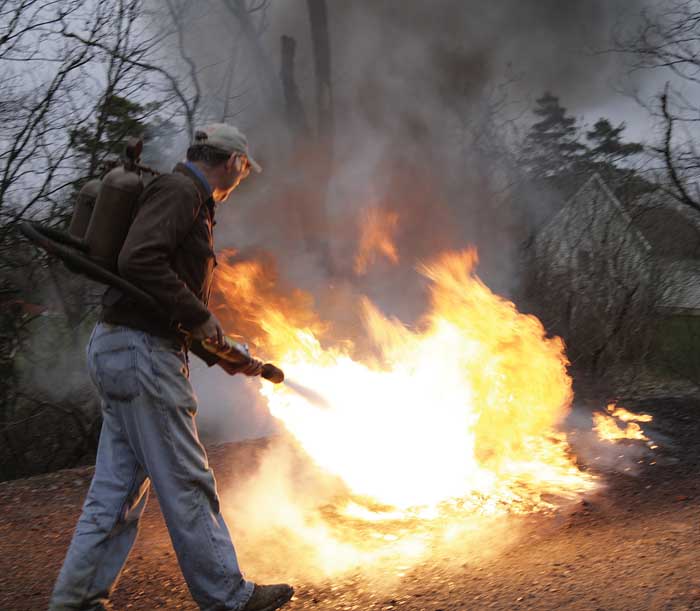
In June 2008, at the Mid Atlantic Air Museum Air Show, The Paris Island Historical Group had the chance to fire side-by-side both the US M2-2 and the Japanese M100. Performance was nearly identical when the M100 was full, but the M100’s volume of fire fell in a few seconds, while the M2-2 continued to give full volume of fire. Both flamethrowers lasted the same amount of time, but if the Japanese were filled to a higher pressure it would have burned faster.
The Japanese Model 100 was an effective and modestly reliable flamethrower, capable of accomplishing its missions as effectively as any flamethrower of its time. It was light, used pyrotechnic ignition, and had a shorter wand, features which were more advanced than any other flamethrower designs of the time. Without doubt, many of its features could have been improved, but it was a well designed weapon with many advanced features. Many of these features were copied by the US, improved upon, and incorporated into the design of the second model US flamethrower, the M2-2.

| This article first appeared in Small Arms Review V13N2 (November 2009) |



